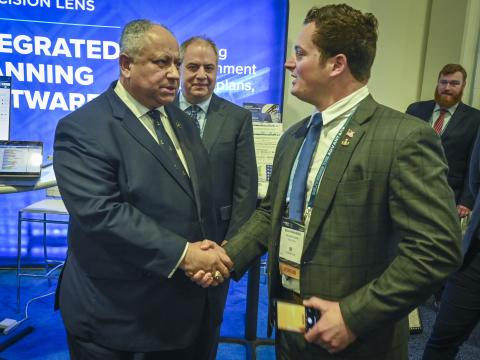Troops in Afghanistan Bridge Communications Gap
Steady progress in communications in the Islamic Republic of Afghanistan has dramatically sped up the pace of coalition combat, security, governance and development operations throughout the country. From the tactical perspective, this progress is increasing shared situational awareness and boosting collaboration among nations.
Lt. Col. John Burger, USA, chief, Strategic Programs Branch, J-6, U.S. Central Command (CENTCOM), MacDill Air Force Base, Florida, explains that at the opening of operation Enduring Freedom, the U.S. services used the available radios and networks to create the main hub areas in the tactical signal units. Staying in touch primarily meant using mobile subscriber equipment and other devices that rely on line of sight for communicating.
The terrain fundamentally distinguishes communications in operation Enduring Freedom from communications in operation Iraqi Freedom, Col. Burger points out. While line-of-sight communications capabilities can be used to share information for miles in the desert or over other relatively flat terrain, in
Lt. Col. Brett
During the past seven years, other advances also have facilitated tactical communications in
Col. Reister relates that the goal during the past several years has been to provide network services as far down the chain of the command as possible. “[I]t's critical that we push the services down to the lower levels because that's the kind of fight that we’re in,” Col. Reister explains.
The Afghan government’s emphasis on building up communications enables citizens to be able to assume the operation and maintenance of the infrastructure when it is handed over to them, Col. Burger notes.
Challenges that arose in joining the networks included guards for service—such as e-mail guards and telephone guards—as
The end result of this work has been improvement over the past seven years not only in combat operations but also in the other support missions conducted by coalition forces: security, governance and development throughout
Col. Burger adds that better communications also has improved situational awareness, including blue force tracking. “Before, we would be blind to a lot of that, other than a voice explaining [what was going on]. Now, we have a little bit better picture of where folks are,” he says.
Despite how far communications in
From CENTCOM’s perspective, Col. Burger says improving information sharing requires separation technologies that enable the right amount of separation—either virtual or logical—so the command can put more networks on one infrastructure.
Standards and simplification are the final two items CENTCOM and the



